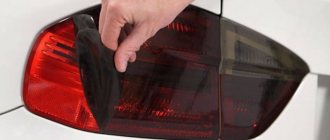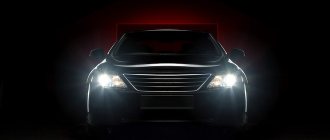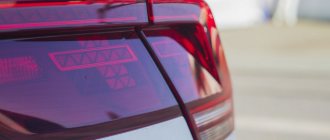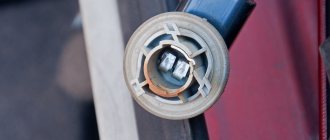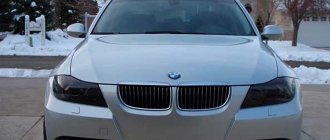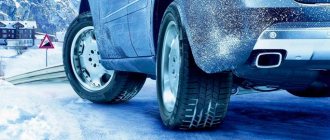Fog lights and lights
This type of light source is part of the overall vehicle lighting system. Lighting equipment is designed for more intense illumination of the road at night, as well as in bad weather, when the visible distance is insufficient for safe movement. This system includes:
- Headlights, taillights and brake lights.
- Car showroom lighting, glove compartment lighting, luggage compartment lighting.
- Front fog lights and rear fog lights.
- Illumination of registration plates and information control panel instruments.
How to adjust headlights
To begin, choose a wall that you can approach at a distance of about five meters. Check that the car is level. Turn on the headlights and check the reflection on the wall to see if they shine evenly.
It is most convenient to adjust the headlights at dusk, since the light on the wall will be more contrasting than during the day. If you don’t find any difference in the light, congratulations, you don’t need to adjust your headlights. If one beam of light is lower than the other, you will have to adjust the light.
To check which headlight is used to determine the “correct” adjustment, ask a person to stand against the same wall. If your assistant is of average height, the headlights will shine at the level of his knees. This is the correct adjustment limit.
Types of foglights
According to traffic regulations, the use of fog lights is officially permitted; many manufacturers equip factory-produced cars with fog lights. But many universal types are also produced by third-party companies. By type there are:
- Front fog lights;
- Rear fog lights.
The design features differ in the source of light used. Common types of fog lights:
- Halogen. Relatively inexpensive light sources, in demand among car enthusiasts. The disadvantages include the short service life of the lamps. During intensive use, they require frequent replacement;
- Xenon. The characteristics of the light spectrum are better than those of halogen lamps. They work long enough. The price is quite high;
- LED fog lights. The highest price category. Lamps with excellent light beam. They have a long service life. Lamps are prone to overheating. Requires fairly good ventilation.
How to determine the visibility limit?
The use of fog lights is strictly regulated by traffic regulations. Poor visibility of the roadway is when the visibility to the car in front is less than 300 meters at dusk, as well as in a situation where it is raining, foggy or snowing heavily. How can you tell by eye in bad weather that visibility is limited? It is necessary to count the power line supports that are installed along the road. If less than 6 pieces are visible, then the view is difficult and is less than 300 meters. The distance between the pillars is fifty meters. In such conditions, it is necessary to reduce the speed of the vehicle and be extremely careful.
Diagram of parallel connection of fog lights
The electrical circuits for installing fog lights differ only in the number of positive wires stretched to the lamp bases. The sequential circuit involves laying one cable from pin “87” to the left headlight. At the place where the terminal is attached, a second wire is connected to it, which stretches to the base of the right lamp.
Parallel activation of the PTF involves laying a pair of separate cables from the relay to each fog lamp.
In addition to the two wires to the PTF lamps, you can run a third one, going to the “control”, which signals the activation of the fog lights. It is installed on the instrument panel. There is a place for it on all modern cars. The only thing you need to connect is to buy a base and a lamp (incandescent or LED) of the appropriate size.
Power cords should be routed so that they do not pass near hot or sharp parts of the machine. In places where the wire may be bent or the insulation may be damaged, they should be protected with corrugation or an additional layer of electrical tape.
After installation and connection of the PTF, it is necessary to adjust the position of the beams. Headlights should not shine upward. Otherwise, they will dazzle oncoming drivers, but will not help you see the road in the fog. You should also make sure that the beam clearly illuminates the side of the road. This will help you pass inspection without any problems and ensure good visibility even in fog or snow.
When are fog lights used?
According to standard No. 19.4 of the Traffic Regulations, front fog lights are designed for additional illumination of the roadway at night or when dusk falls, together with headlight devices. Use is permitted in unlit areas or in conditions of limited visibility caused by weather conditions. And also as running lights, instead of low beam, according to paragraph No. 19.5, during the day. A detailed explanation of traffic rules and GOST can be read in this article: https://businessman.ru/new-dnevnoj-xodovoj-ogon-razyasnenie-gost-i-pdd.html. Separate regulations apply to the operation of rear lights. When according to traffic regulations do you turn on the fog lights installed at the rear of the car? Rear fog lights are intended only for additional identification of the vehicle in conditions of poor visibility: fog, snowfall, heavy rain, etc. Turning on in normal situations is prohibited.
Differences in car headlight designs, self-adjustment capabilities
In most domestic cars and budget foreign cars, the head light is distributed evenly along the road surface; such lighting is called symmetrical.
To a driver on a dark, straight road, a properly adjusted light looks like two identical, evenly illuminated spots of light starting a meter from the front bumper (for low beam) or an arched “light tunnel” for high beam. Correctly setting the low beam is characterized by a sharp boundary between the light cone and the shadow.
Without affecting expensive cars with adaptive (turning) headlights, the lighting systems of many European brands are built on the principle of asymmetric lighting.
For asymmetric lighting, specially designed reflectors and lensed glass are used. In some models, cutouts in the lamp screen and separate low and high beam headlights are used to bend the low beam light to the right.
The driver can independently identify the incorrect luminous flux by illuminating a dark vertical surface from different distances. A light cone pointing to the left requires immediate adjustment. Evenly raised or lowered lights are less dangerous for oncoming cars, but do not illuminate the road well for the driver.
Installation
It is worth paying attention to the correct installation of additional lighting sources. Installation of fog lights according to traffic regulations in Russia has some features and limitations:
- The emitted light should be in the milky white spectrum or have a bright yellow color.
- Installation of only paired directional light sources is permitted. The type of lamp used must be of the same type.
- Installation of an additional device is possible no higher than the level of stationary car headlights. The lowest point should be higher than 25 centimeters from the surface of the roadway.
- According to the dimensions of the vehicle, the separation cannot exceed 40 cm (for a vehicle width of 1.3 m) and 60 cm (for others).
- The connection of the fog lights must be connected to a separate toggle switch.
- The angle of the emitted light beam should be between -10 and +15 degrees vertical.
- The horizontal angle should be between -10 and +45 degrees.
The rules do not regulate the exact installation location.
Rear fog lights
It is prohibited to connect rear fog lights together with brake lights. It is also not allowed to turn on the rear fog lights if the overall visibility is equal to or higher than 300 meters. Such restrictions have objective reasons. The brightness of the rear fog light sources is the maximum of all the lights present in the rear of the vehicle. They are even brighter than brake lights. With sufficient visibility in normal weather conditions, they cause blinding of drivers behind the cars. It is also strictly unacceptable to combine the buttons for turning on and off the front and rear fog lights.
Additional LED lights
What do the regulations say about installing LED fog lights?
To answer this question, let's start with the main headlights. Is it possible to change the headlight bulbs recommended by the manufacturer to xenon or LEDs? Traffic regulations give a precise answer: if the manufacturer recommends or could install non-halogen light diffusers on the conveyor for a specific car model, then “upgrading” is permissible. To put it simply, everything that is included in the vehicle configuration is permissible, everything that is not provided is prohibited. If you simply replace halogen lamps with LED fog lamps, then due to the design features of the headlight (the diffuser lens only works correctly with the lamp intended for it), there will be almost no good effect. The headlights will, of course, emit more light, but the beam formation will be incorrect. It will not be possible to achieve the desired result without replacing the headlights themselves, except for blinding oncoming drivers.
All the same rules apply to fog lights with LEDs. The installation of fog lights not provided by the manufacturer according to the traffic rules (Article No. 12, paragraph No. 5) provides for punishment. It is illegal to operate a vehicle with lights that are not designed for a specific model. Will lead to deprivation of a driver's license for a period of 6 to 12 months with confiscation of light sources.
Photos provided by the Internet agency "DreamTrade"
The subtleties of installing plastic pipes with your own hands
There are several nuances that should be observed to ensure that the system works correctly in the future:
- Cutting pipes must be accompanied by cleaning their edges from burrs. To make the job easier, you should take a saw with small teeth and a wide blade: the cut will be made at a right angle, and the number of burrs will be minimal.
- Before assembling sewer pipes, it is worth performing preliminary assembly, during which control marks are applied. After this, the system is disassembled.
- When laying a pipeline in a wall, metal pipes are most often used, which are connected to plumbing fixtures using plastic pipe sections. To connect different types of pipes, couplings that do not have sockets are used.
- When drilling a hole for the pipe, the stand may become loose. The problem can be eliminated with the help of special overlays that return the racks to their original strength.


